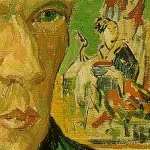
I've visited New York a million times. During the 80s my sister lived in Chelsea, and I used to regularly take the train up from Washington to visit. My wife's family, moreover, originates from Queens, and many have resettled no further than Long Island, necessitating several more New York visits over the past seventeen years of our marriage. Yet it was not until just a couple years ago, when AWP held its conference in New York, that I finally made it to the Museum of Modern Art--what everyone calls MoMA. This is curious, because one of the first things I usually do when visiting a city is to check out the art museums. Curious too because over time I've lost patience with much--but certainly not all--of the pre-20th century art that I once admired and studied. Leanness and intellectual complexity are the qualities that I seek in art now, rather than flabby, over obvious, forms. MoMA should have been a natural pilgrimage for me. But what forced me to finally take the visit was not a devotion to 20th century art but my Van Gogh novel. You see, Van Gogh's iconic painting Starry Night (1889) hangs in the MoMA. I don't feature the painting in my novel. I don't dramatize, nor even mention, its composition. (Ironically, there's scant mention of it either in Van Gogh's letters.) If the point of my book is simply a tour of Vincent Van Gogh's Greatest Hits, then it's not a novel and I have no interest in writing it. I have to highlight paintings that fit the scenes I'm composing. This means that many many well known Van Gogh paintings get ignored in my book. Tough. (I actually had a lot more fun with the lesser known works.) That said, I couldn't not see Starry Night, could I? Not when I had a chance? Arguably the most famous Van Gogh painting of all, and the crown jewel of the whole museum? No, I couldn't. So in February 2008 I made the quick hike to the MoMA from the hotel where I was staying for the conference. I'd do it. I'd finally see Starry Night.
I almost wish I hadn't. Starry Night is without question a great, even radical, painting. That's apparent as you stand there jostling elbows with the fifty other people hoping to catch a glance at it. But it simply didn't blow me away. And let me assure you that my experience of seeing Van Gogh paintings in the flesh--not those dopey, insufferable reproductions that get stuck on everything from t-shirts to baby bowls--is that I Get Blown Away. The light and heat radiating from the Sunflowers series, for example, is so palpable you can measure it in degrees and lumens. Same for many of his Arles portraits, such as L'Arlésienne (1888), and landscapes such as The Sower with the Setting Sun (1888) a picture that so astonished me when I saw it in Amsterdam in 2001 that I was still thinking about it eight years later when I wrote the last scene of my novel (in which it features prominently). But it's not only the bright pictures I've been impressed with. The Van Gogh Museum in Amsterdam also displays many works from his Dutch Period. The smoky, oaky, oppressive weight of these pictures--most notably The Potato Eaters (1885)--is just as impressive and just as moving, if in a completely different way, from his simmering Arles summer works. The point is, they all impress.
Starry Night didn't impress me. It looked dingy and faded, as if its sparkle had sunk underwater and been cauterized by seaweed. It didn't have much to show or to tell me. It seemed a painting that we were staring at because we all thought we were supposed to stare at it, not because it was entrancing. Others may disagree--I'm sure others will disagree--but that's what I saw. Van Gogh was known to rely on inexpensive, inferior quality paints because of his poverty, paints that degraded more quickly than most. As brilliant as his paintings
shine--I've heard experts pronounce--they probably shined even brighter in his own time, a thought that is both uplifting and almost impossible to entertain. Perhaps Starry Night is a victim of such degradation. I don't know. I am neither painter nor art historian. That day in the MoMA I was merely an appreciator. I stood in front of the painting for long minutes, letting it touch me as it would. But finally I had to walk away in search of other works, not much touched at all.













0 comments:
Post a Comment